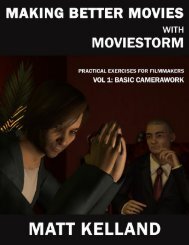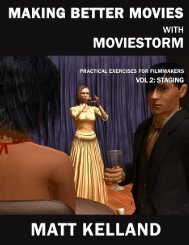Making Better Movies with Moviestorm Vol 3: Sound and Light
Making Better Movies with Moviestorm Vol 3: Sound and Light
Making Better Movies with Moviestorm Vol 3: Sound and Light
Create successful ePaper yourself
Turn your PDF publications into a flip-book with our unique Google optimized e-Paper software.
REALISTIC AMBIENCE<br />
Go to a busy location, close your eyes, <strong>and</strong> make note of all the sounds you hear. Ideally, get a good recording<br />
device <strong>and</strong> record the sounds. An urban street, crowded shopping mall, or busy office are all good examples.<br />
Film the scene <strong>with</strong>out ambient noise, <strong>and</strong> just focus on the dialog.<br />
Now add in as much ambient noise as necessary to make it realistic – you can simply add the recording you made<br />
earlier. Add in dialog for the extras if appropriate. You may need to adjust your camerawork.<br />
Review<br />
Can you make out what the characters are saying?<br />
What does the background sound add to the mood or style?<br />
Does your “real” sound actually sound realistic when it’s in the film?<br />
What did you have to adjust between the two versions?<br />
Followup exercises<br />
Try it <strong>with</strong> different scenes <strong>and</strong> genres to see where this technique works well <strong>and</strong> where it doesn’t.<br />
Build up an ambient sound completely from scratch, <strong>and</strong> compare it to the sound you recorded on location.<br />
Experiment <strong>with</strong> adjusting the ambient volume between shots but <strong>with</strong>out making it feel artificial.<br />
14




